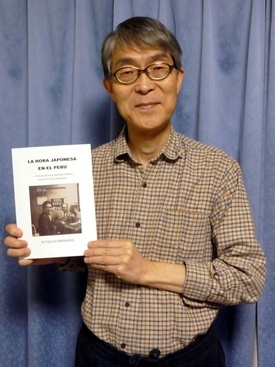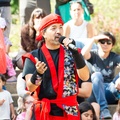Tetsuya Hirahara is a diexistist and a hobbyist researcher. Since he first picked up a Cuzco station 44 years ago from Japan, Hirahara delved deeper into Latin American radio stations and in the midst of the Internet era, he discovered that Japanese radio programs existed in Latin America. Thus, he began to investigate the history of La Hora Japonesa in Brazil, Argentina, Bolivia, Paraguay, Mexico and Peru. After several years of research, Hirahara published two books in Japanese: A Hora Japonesa (Brazil edition, 2010) and La Hora Japonesa (Latin America edition, 2012). This year, it has just launched the Peru edition: The Japanese hour in Peru , available for free download in PDF format.
* * * * *
What do you currently do?
I work in the electrical energy industry, as a consultant for its commercial department, handling contracting and managing projects. Although I retired last year because I turned 60, I still work in the same office, but with an annual contract. So, practically, I'm like a newly hired employee [laughs].
How did your interest in Diexism and Latin America arise?
Since I was in high school, I was interested in Diexism. I started with an NEC portable radio to listen to stations from Japan. Then, foreign stations in Japanese. The only way to listen to vernacular music was through radio stations captured from abroad. The melodies of the charango and the quena moved and fascinated me from the bottom of my heart.
How did the initiative to write a book about Japanese Time in Peru come about?
In 2013, Álvaro Ito, then a journalist for the newspaper Peru Shimpo, interviewed me when I was in Lima and at his suggestion, I decided to prepare the Spanish version of the chapter on Peru. It is a chapter that details the history of radio programs destined for the Japanese colony in Peru.
What difficulties did you have?
During my stay in Lima several years ago, I visited some radio stations that at that time broadcast Nikkei radio programs and interviewed several of their protagonists. I also took the opportunity to visit the archives of newspapers like Peru Shimpo. But difficulties arose when he could not find all the information, because not all editions of the newspaper have been preserved and many of those interviewed no longer remembered the events clearly. Added to this was the search for the interviewees, most of whom were already far from the radio world. As there are practically no sources or writings on the history of Nikkei radio because it is a means of non-written communication, the testimonies and notes from the time published by Peru Shimpo were my main source of information. Due to the budget issue, I have presented the book in PDF format (for free download and open access).
Could you tell us about your book?
Japanese time in Peru covers the first radio concerts in Peru with Japanese artists, such as the tenor Yoshie Fujiwara, who made a South American tour, including a visit to Peru in 1938. On the central theme, the radio programs of Lima that appeared between the 50s and 80s, starting with La Hora Japonesa by Shozen Irei in 1952 and which had several similar versions on different radio stations in Lima and the provinces. I have included testimonies with anecdotes from the same protagonists (announcers, broadcasters and radio collaborators). Everything is duly supported with oral and written sources of the time.
What projects do you have for the future?
Currently, I am advancing research into the history of Japanese Time in the US, Canada and Hawaii. The next book will be the North American edition.
If financing were possible, what would you like to do?
The ideal would also be a printed edition, but for now, I was only able to present the book in a digital edition. I would like to delve deeper into the topic, because there are still many things to clarify, for example, what The Japanese Hour was like during the military government in the first half of the 1970s. More testimonies are needed. On the other hand, I would like the study of The Japanese Hour to be further studied in a more academic way based on the research I have carried out.
DATA:
Website: http://radiophj.web.fc2.com/peru.html
Contact email: radiophj@yahoo.co.jp
* Article originally published in the Peru Shimpo newspaper on November 22, 2018.
© 2018 Peru Shimpo







